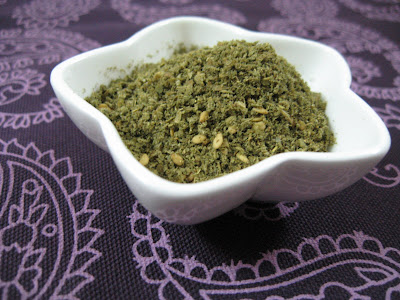 Za’atar is an aromatic spice mixture used in the
Za’atar is an aromatic spice mixture used in the A friend of mine got me Za’atar from
The type of za’atar mix differs depending on the region. My mix contains thyme, sesame, sumac, caraway, dill, turmeric, roasted wheat, salt and vegetable oil. With so much za’atar at hand, I found out some fun ways of using them. I’ve found a bunch of things with I could use it, one of the experiments was a za’atar chicken pilaf – a tad less hot for my taste, but quite flavourful and fragrant.
Za’atar can be used as a tabletop condiment – I say, sprinkle away on anything you eat. This is a good way to judge how much it complements your regular food. For a nice appetizer, cut pita bread into wedges, sprinkle with za’atar and olive oil and bake for 5 minutes at 200°C. Za’atar is used as a seasoning for meats and vegetables. It can be mixed with olive oil to make a spread or you could add some to a bottle of olive oil for the flavours to infuse – but this should be consumed quickly. It tastes so good when sprinkled on some garlic rice. I love a thick layer of za’atar and olive oil paste as a part of as a savory tart (mankeesh Za’atar). A few days ago I made some Shish Taouk and garlic rice sprinkled with za’atar. It was so good. But that’s makes for another post. Za’atar is often sprinkled on hummus too. I’m so excited about using this versatile herb mix for a ton of creative experiments!
Labneh
After hearing so much about labneh I thought I’d make some of my own today. I bought some full fat milk (to make it so, so creamy) to set some fresh yoghurt. What you’ll need:
Yoghurt
Salt
A clove of garlic
Extra virgin olive oil
Za’atar
Here are the steps I followed:
- Hung the yoghurt in a muslin cloth for a couple of hours until all the whey drained out (about 3 hours).
- Mixed the drained yoghurt with some salt and a whole clove of garlic until it had a hint of the flavour and then I tossed it out (since raw garlic can be so overpowering).
- Spoon the creamy mixture on a plate and splash with some extra virgin olive oil.
- Finally, sprinkle with lots and lots of za’atar!